Bikes as fit constructs
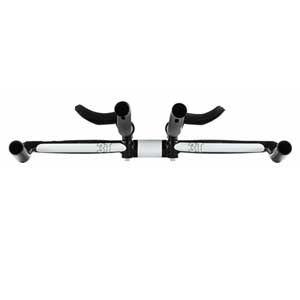
Avid followers of our reader forum have been sitting though involuntary "school" on bike fit concepts, and its terms of art, over the past couple of weeks. The point behind those forum threads was a pair of upcoming articles.
The first of the articles is here, and its theme is this: Bicycles are constructs of assemblies. Of course you know this already! Shifters don't shift, unless there are also derailleurs to actuate the shift. Cranks don't transmit power to the drive train unless pedals and a chain attach to them. The chain must transmit the power from the crank to the back wheel.
But I'm talking strictly about how bikes fit. The notion that a frame alone determines fit is entirely wrong.
Yes, it's true that a frame might trend toward long-and-low, or narrow-and-tall. But that trending is modified by the geometry of the aerobar you put on the bike. Consider two aerobars: a 3T Aura, and a Vision Clip. The 3T bar has armrests that sit 6cm above the centerlne of the pursuit bar (where it passes through the stem's handlebar clamp). The Vision's aerobar pads sit only 3cm above the handlebar clamp.
Let's say you took possession of a new Cannondale Slice. However, let us also say that you admired the 3T Aura as an aerobar. The Slice comes with the Vision clip-on. If you changed nothing about the bike, rather you simply de-Visioned the bike and 3T'd it instead, once you sat aboard your new bike the armrests would be sitting much higher in the air (as the stick figures in the image below illustrate).
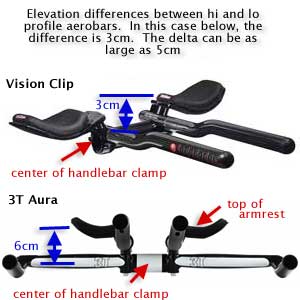
Now, don't assume this is a bad thing. It might be good. However, as we've discussed in these recent forum threads, it's very likely a bad thing in the case presented, because the Slice is already a fairly narrow-and-tall frame. If you place a "high-profile" aerobar on an already tall-fitting frame, you've got aerobars that are really high up in the air relative to that bike's length.
And this is precisely what Cannondale has had in the past with its Slice. Previous to this year, Cannondale spec'd Profile Design's T2 aerobar, and that was, in my mind, a bad match. Mind, they were two good products, they simply weren't good together, at least if you're trying to get your bikes to fit the fat of the bell curve of riders.
So, Cannondale replaced its Profile Design T2 spec with Vision spec, and I think the bikes are now going to fit a wider range of folks as they are spec'd and sitting on showroom floors.
Now, let's use Felt as an alternate example. Its geometries are rather middle of the road, or trending gently toward the long-and-low. But its aerobar used on its high-end bikes is its own Devox bar, and it's not middle of the road. It's decidedly low-profile. Again, no problem here. Still, that Devox bar has even greater utility on narrow-and-tall bikes than on Felt's own bikes, and it could be that a higher-profile aerobar might be a good match for a Felt bike in many cases (in my own garage is a Slice with a Devox bar, and that combo fits me perfectly). Furthermore, 3T's (high profile) bars were ridden on Felt's bikes by the Garmin team for the last two years.
Likewise, Cervelo's long-low P3 has had a 3T sitting aboard it during the past year of its Test Team, and prior to that Cervelo and 3T were a match for the Saxo Bank team and its precursors.
A short list of aerobars, and the vertical distance between aerobar pads and handlebar clamps, is below:
Felt Devox: 2.5cm
Vision Clip: 3cm
Profile Design CX3: 3cm
Zipp Vuka: 4.5cm
Profile Design T2: 6cm
3T Aura: 6cm
Syntace C2: 7cm
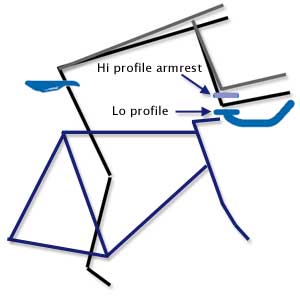
When I was making tri bikes, my geometries were quite long and low: more so than almost all bikes made today. Why? Because for most of this time, the ruling aerobar was the Syntace C2, or other Syntace models that shared with the C2 the same armrest platform. As you can see from the list of aerobar pad heights just above, the aerobar's geometry took up so much height that the frame's geometry had to shrink in height so that our aerobar of choice could fit!
For this reason, when you enter a fit session that includes mounting and riding a fit bike, it's absolutely critical that you consider the choice of aerobar first. This, because, the fit session's output—the list of frames you'd fit aboard best—will differ dramatically if your fit session occurs aboard a Felt Devox versus a Profile Design T2.
This doesn't mean that high-profile bars can't ever successfully be used on narrow-and-tall bikes. Just, the riders using set-ups like this tend to sit on one end of the curve, just as riders using low-profile aerobars on long-and-low bikes sit on the other end.
Consider a rider who's got long legs versus his torso. That rider's legs pitch him up in the air, and his frame needs to be tall to fit up underneath him. But the frame can't be long—his short torso wouldn't fit aboard a long frame. He might need not only a frame that's narrow-and-tall, he might also need a high-profile aerobar.
Furthermore, this is affected by how steep you ride. If you ride a steep seat angle, as your saddle moves forward it "pushes" the front of your bike further forward as well. This requires your ideal bike to be geometrically longer, to accommodate this steep riding position. And—on paper at least—the steeper you ride, the lower the front of your bike is likely to be (the more armrest drop).
But the reverse is also true. If you ride less steep, you need a narrower bike, and a correspondingly taller front end.
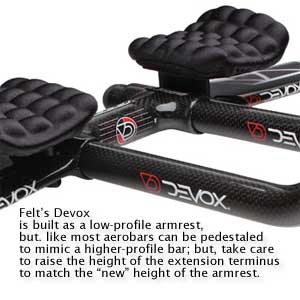
So, imagine the rider who rides only mid-steep, and who's got very long legs versus his torso. He's a fitter's nightmare, for two reasons: He's going to need a narrow/tall bike mated with a high-profile aerobar, and he's going to have a devil of a time not hitting the backs of his armrests with his knees.
The reverse is also true, of course. The longer your torso, the steeper you ride, the lower you are in front, the more you're a candidate for long-and-low bikes with low-profile aerobars.
Still, the safest bet is for bike makers to spec their bikes with aerobars that are a thematic contrast to their frames: long/low frame makers are best spec'ing something other than a low-profile aerobar; high-profile bars ought not be aboard narrow/tall frames. While these low/low or high/high combos might be a good match for specific customers, it's a bad match for original equipment spec.
And for this reason, you can't simply say that you, as a customer and a rider, are best suited on a long-and-low or narrow-and-tall frame. Rather, you are a match for a particular geometric style of bike matched with a specific geometrical style of aerobar.
This leaves one thing to consider: What about that last final element of the construct—the parts that go in-between? I'm talking about the (evil!) stem. This is a huge part of the decision because, as we will see in the next and final article in this tutorial, the stem you choose will in large part decide the geometric style, and the size, of the frame you select.



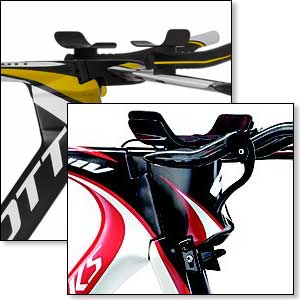
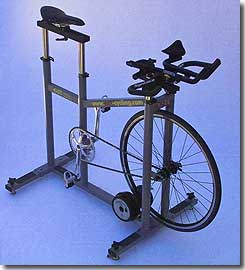

Start the discussion at forum.slowtwitch.com